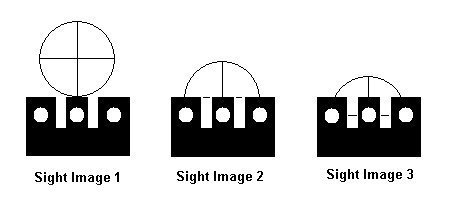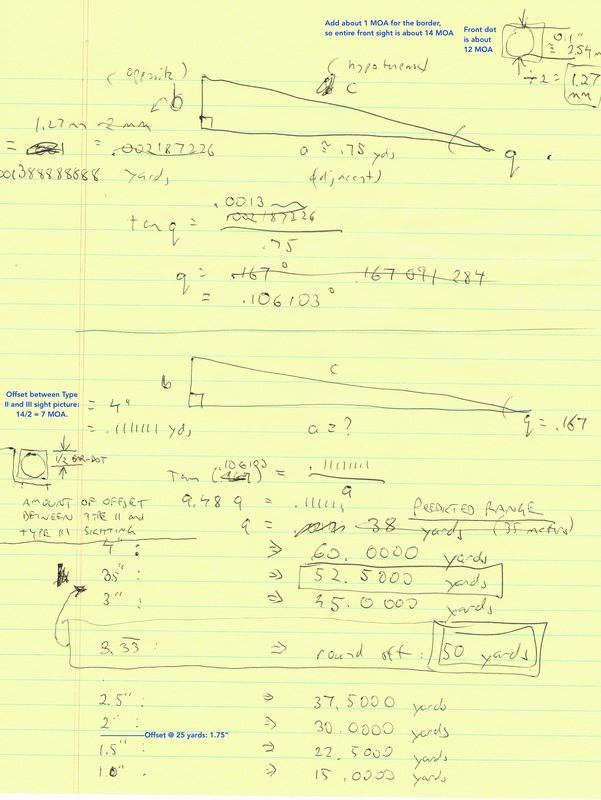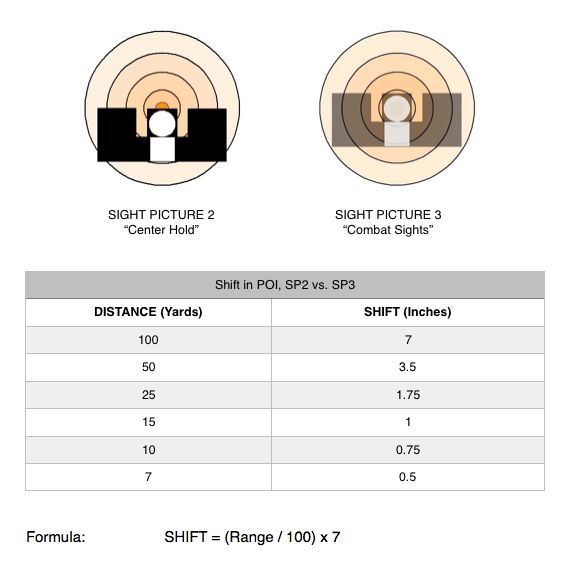Page 1 2
Go  | New  | Find  | Notify  | Tools  | Reply  |  |
| Gracie Allen is my personal savior! |
At least on SIG CS rep has told me that the factory simply doesn't have access to a range that's longer than fifteen yards. I'm willing to believe it simply because I have no reason not to, but that's as odd as the "combat" sight setup. | |||
|
"Member" |
I usually tell people "Be sure to yell "Statistics show most gunfights take place between ten and twenty feet!" really loudly while you're running for cover." But really, combat sights? Gunfights? I don't know about you, but I dont get into nearly that many gunfights these day and I'd like to be able to hit smaller things farther away the other 99.9% of the times I use my guns. _____________________________________________________ Sliced bread, the greatest thing since the 1911. | |||
|
Ammoholic |
You really find that the Combat sights (#3) work better at distance than the Center Hold (#2)? I think you are the only one I have every heard say that. For me if I can't actually see what I am hitting it makes it harder. I like to split the bullseye with the top of the front sight (#2). What if you are shooting small dots or small steel at decent distances? If your sight covers all of the target, how do you know that you are on it?  Jesse Sic Semper Tyrannis | |||
|
Lost |
I pretty much agree with this for the most part. While I understand the theory behind combat-sighting, I don't really like it. I don't like covering the target (it is different with an electronic dot, which superimposes over the target without obscuring it.) So I changed out the factory sights on my P229R, and it now sports a set of Heinie sights set up for center-hold sighting. Now only half the target is covered. Very accomodating to precision sighting. | |||
|
| Member |
I use the Sig recommended way and it seems to work ______________________________ Retired Navy RM/ITC(SW) 1982-2002 USS Edward McDonnell (FF-1043) Mayport FL USS Pegasus (PHM-1) Key West FL. USS Carl Vinson (CVN-70) Bremerton WA. Sig P938/238 Equinox Sig P320C RX Colt Mustang XSP FE | |||
|
| Member |
I really don't think the difference between #2 and #3 is as great as everyone thinks it is, probably not more than two inches at 25 yards. I actually use both depending on the situation. If the target looks small, I use #2, if the target looks big and I'm going for speed or if it is dim and I need the tritium I use #3. I do find it interesting that many people make a distinction between a red dot obscuring the target (OK) and a dot on a front pistol sight obscuring the target (not OK). ------------------------------ "They who would give up essential liberty to obtain a little temporary safety, deserve neither liberty nor safety." - Benjamin Franklin "So this is how liberty dies; with thunderous applause." - Senator Amidala (Star Wars III: Revenge of the Sith) | |||
|
Lost |
The dot on the pistol is surrounded by the rest of the front sight. It's not just the dot, which is also generally larger than a red dot and not at all translucent. | |||
|
| Member |
I guess that depends on the specific sight. I shoot the AmeriGlo Pro-Glo sights. The dot is the same size as the sight width and it is positioned flush with the top of the sight, so the only extra coverage you are talking about is the top corners. I'm not really missing much in my ability to identify my target. Besides, at the moment of firing your focus is supposed to be on the front sight, so the target will be a blur anyway. I'll give you that it is larger than a typical red dot, so I will use either the top of the sight (or the top of the dot) for distance or precision shots. ------------------------------ "They who would give up essential liberty to obtain a little temporary safety, deserve neither liberty nor safety." - Benjamin Franklin "So this is how liberty dies; with thunderous applause." - Senator Amidala (Star Wars III: Revenge of the Sith) | |||
|
Lost |
It does depend on the specific sight, but even if it's just the corners, it does tend to add all up in my mind. So you got the corners, the larger dot to begin with (most red dot are what, 1-6 MOA? The dot on a Sig is a whopping 12 MOA.), and the fact that you can dial down the intensity on an electronic sight until the dot itself becomes somewhat translucent. Added all together, I think it makes a significant difference. Putting it more simply, you're losing all the targeting information directly behind the front sight blade. At close, typical SD ranges, not much of a loss I agree, but shooting at small, bullseye targets at larger ranges, it can be the entire target board. | |||
|
Lost |
I've actually done some analysis of this situation, and my calculations couldn't agree more. Summarizing my findings, the difference between Sight Pictures #2 and #3 is around 7 MOA, or about 7 inches @ 100 yards. Dividing by 4, the offset @ 25 yards calculates to 1.75". I think that agrees pretty closely with your statement "probably not more than two inches at 25 yards".  This message has been edited. Last edited by: kkina, This message has been edited. Last edited by: kkina, | |||
|
At Jacob's Well |
I prefer sight picture #2 because I like to index the top of the front post with the top of the rear sights. Trying to line up dots is fine, until you move to a gun that doesn't have three dots. Lining up the top of the sights works with almost all standard sights. And since I'm already looking at the top of the front post for alignment, it makes sense to also use it for aiming so that I only have one visual point to track. Front sight, front sight, front sight. J Rak Chazak Amats | |||
|
| Member |
It could also be argued that lining up the top of the sights is fine until you are in low light and need to use the dots. As kkina's calculations show, it really doesn't make that much difference which you use as long as you can use one or both of them consistently. With my aging eyes, sometimes trying to clearly see the top of the front sight can be a challenge, which is why I've gravitated to using the dots more. Much like the issue of using the slide release versus pulling the slide back to complete a reload, I don't think this one falls into the category of dogma (unless someone is trying to use #1 for anything other than bulls eye competition). Use what works for you and let others use what works for them. ------------------------------ "They who would give up essential liberty to obtain a little temporary safety, deserve neither liberty nor safety." - Benjamin Franklin "So this is how liberty dies; with thunderous applause." - Senator Amidala (Star Wars III: Revenge of the Sith) | |||
|
Lost |
Maybe it's useful to know the exact POI shift, for various ranges, between Sight Pictures 2 and 3. That way you can decide for yourself whether the error is significant enough to worry about.  This message has been edited. Last edited by: kkina, This message has been edited. Last edited by: kkina, | |||
|
| Member |
So I did a little testing this weekend. The target on the left was shot using sight picture 3 and the target on the right was shot using sight picture 2. Head shots were at 7 yards and body shots were about 20 yards. One interesting thing I noticed with the AmeriGlo sights was that it was impossible to line up the top of the sights and the dots at the same time. If the top of the sights were lined up, the front dot was a bit higher than the rear dots and if all 3 dots were lined up, then the top of the front sight was a bit lower than the top of the rear sights. The take away from this for me is that you can use either the #2 or #3 sight picture, just make sure you have whichever reference point you will be using properly aligned with the rear sight. When I did this, there was no practical difference. ------------------------------ "They who would give up essential liberty to obtain a little temporary safety, deserve neither liberty nor safety." - Benjamin Franklin "So this is how liberty dies; with thunderous applause." - Senator Amidala (Star Wars III: Revenge of the Sith) | |||
|
Lost |
Thanks for doing this research, RichN. Here's my analysis on the data you gathered... First of all, the two nice targets you presented. My calculations predict a 1.4" difference between SP2 and SP3 at the distance you shot, i.e. 20 yards. Shift = (20/100) x 7 = 1.4" So looking at the COM shots, and allowing me the liberty of calling one low flyer from the left group, I believe I can see a difference of about an inch-and-a-half in the vertical groupings' center point-of-impact. Perhaps you can make a more precise measurement if you are so inclined, but I think we have basic confirmation of my figures thus far. (Not sure if the 7 yard groups are worth measuring, but even so theory predicts a 1/2" offset @ 7 yards, and I think I can see that as well. Really! Next, your excellent observation that on your gun the two Sight Pictures can not occur simultaneously. This allows you to actually use the two different sight pics on the same gun. Here's where it gets tricky. I believe this does happen, and is a happy coincidence, but that's all it is. I don't believe the gun/sights were engineered to perform this way. It's just a perfect storm in the good sense, and when it does happen it leads people to think it was designed to work this way. I'd like to see some engineering drawings that show this planned design feature, but I doubt very much they exist. I've seen just as many guns where the sights do match up, or where the offset occurs outside of useable shooting ranges. And of course there's the notion that at most social interaction distances, differences of less than an inch or so simply don't matter. Anyways, thanks again for doing this. I find this stuff extremely fascinating, which I'm sure others have noticed by now. At least it keeps me out of trouble. | |||
|
| Powered by Social Strata | Page 1 2 |
| Please Wait. Your request is being processed... |
|
© SIGforum 2025
